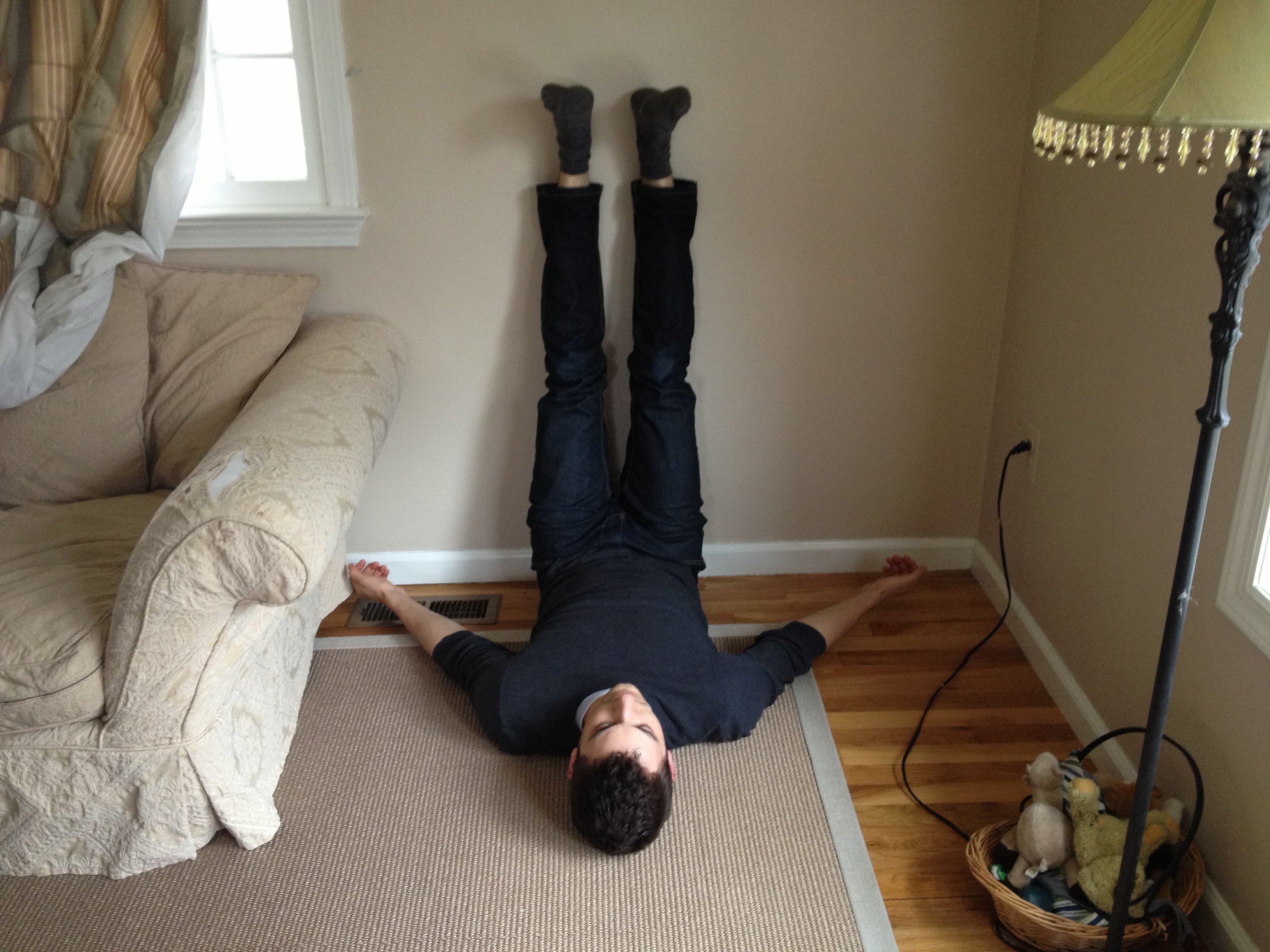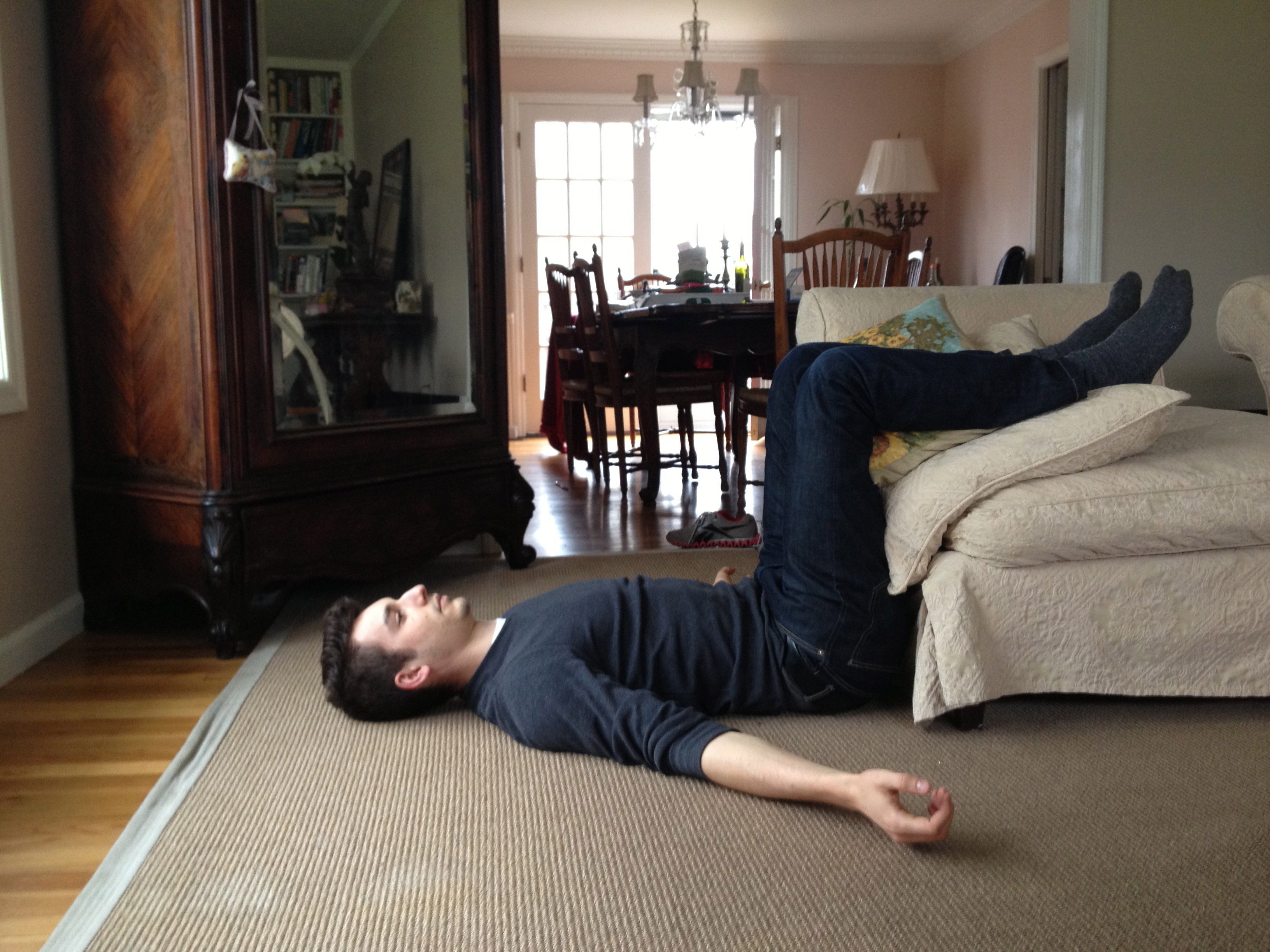Here’s the way I fixed most of my neck pain and how you can, too.
It’s a three part system:
- Egoscue Exercises
- Trigger Point Therapy
- Learn How to Actually Sit Pain Free And Use Your Body (or else it’ll come back)
A. Part 1: Egoscue Exercises For Neck and Shoulder Pain
The Egoscue method works for everything I have tried it on.
Chronic lower back pain, neck pain, knee pain, it always provides relief. So let’s start with that.
If you’re sitting over your computer like a hunched caveman, your neck is grossly out of alignment.
The point of these Egoscue exercises is to let gravity re-align your neck and back.
WHY: This is getting your neck, upper back, and hips re-aligned using the wall.

How to do it:
- Scoot your butt as close to the wall as possible like in the picture above
- Make sure the back of your head is touching the wall, and pull your shoulder blades back, so they are flat against the wall
- Put your hands face up in your lap
- Pull your toes back – so they are flexed
- Hold for 5 minutes

How to do it:
- Lay down on your back like in the picture above – and scoot your butt as close to the wall as possible
- Flex your feet back so they are pulled tight
- Pull your shoulder blades back, so they are flat on the floor
- Let your hands rest, palm up at a 45 degree angle
- Hold for 5 minutes

How to do it:
- Lay flat on your back, and put your legs up at a 90 degree angle on a chair, couch, or object
- Roll your shoulder blades back so they are flat on the ground, and let your arms fall naturally at a 45 degree angle
- Hold for 15 minutes
***
B. Part 2: Trigger Point Therapy
The next thing you should be doing on a daily basis is employing trigger point therapy.
I either use a theracane, a foam roller, or a tennis ball/golf ball.
We’re all familiar with “tension” held in our backs or necks from sitting all day. Trigger points are basically tension on steroids. They happen at localized places, which is good, because we know where to find them and eliminate them.
Sometimes the site of the pain is not the source though – and referral pain can radiate much farther away.
So you might have trigger points in your upper back causing you neck pain or worsening headaches, and you might have butt trigger points causing lower back pain.
So, here’s what to do for self-massage:
I want you to massage three places (don’t worry, there are videos for each):
- Sternocleidomastoid
- Trapezius & Levator Scapulae
- Suboccipital
#1 – Sternocleidomastoid
#2 Trapezius and Levator scapulae
#3 Suboccipital
Again, when you’re employing trigger point therapy it’s important that you massage these places hard, and you do it several times per day (the more, the better – they recommend 6-12 times).
So every hour at work, I would spend 5 minutes going through these 3 quick videos and doing a massage session.
I either use a theracane, a foam roller, or a tennis ball/golf ball. You can also just use your fingers for places like the Sternocleidomastoid.
And again, you can use your fingers, a massaging cane, or when you’re home just grab a tennis ball or golf ball and roll your entire body weight over it.
This is critical for day-to-day pain relief.
***
C. Part 3: Pain-Free Posture (How to Sit Without Pain)
Posture is the really un-sexy origin of your pain.
People don’t really like hearing that, because it’s not a magic bullet, but ultimately if you sit properly throughout the day, you won’t have musculoskeletal pain. Pretty much end of story.
Ultimately, all of this will work in the short run… but like all things related to your health, you must change your habits.
I’m going to assume that 90% of you sit all day at work, and often at home after work. So here’s how to maintain proper posture for your neck, shoulders, and upper back.
First – I would suggest grabbing an ergonomic stand for your laptop if you aren’t already using one.
Rather than looking down at your computer, you want your head to obviously be upright.
If you ignore changing your overall posture throughout the day, you’ll just find the pain coming back and you’ll have to begin from step 1.
- Lower Back
- Upper Back/Shoulders
- Neck
Watch This:
Are My Migraines Caused by Neck Pain/Stiffness?
I’ve noticed that many people with chronic headaches and migraines tend to have chronic neck issues.
For example, neck stiffness has been found to accompany migraines, putting a cold compress around the neck has been shown to significantly help with migraines (origin unknown), trigger point therapy (mentioned above) has been shown to be effective for reducing headaches, and headaches have beenassociated with TMD (jaw) and neck pain.
The link is still up in the air, but I would be thrilled if you went through this, and told me it fixed your chronic headaches.
As to whether or not there’s a conclusive link between the two, I don’t know.
If you want a 30+ page guide on how to fix back and neck pain while sleeping, at your desk, etc. just click here and grab this guide.

No comments:
Post a Comment